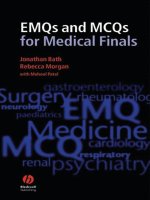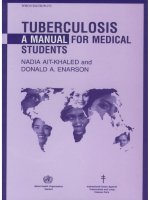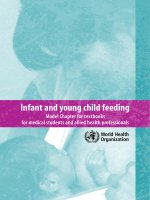Lecture note for medical laboratory science students TOXYCOLOGY
Bạn đang xem bản rút gọn của tài liệu. Xem và tải ngay bản đầy đủ của tài liệu tại đây (781.55 KB, 0 trang )
LECTURE NOTES
For Medical Laboratory Science Students
Toxicology
Dr. Biruh Alemu (MD), Ato Mistire Wolde (MSC, MSC)
Hawassa University
In collaboration with the Ethiopia Public Health Training Initiative, The Carter Center, the
Ethiopia Ministry of Health, and the Ethiopia Ministry of Education
May 2007
Funded under USAID Cooperative Agreement No. 663-A-00-00-0358-00.
Produced in collaboration with the Ethiopia Public Health Training Initiative, The Carter
Center, the Ethiopia Ministry of Health, and the Ethiopia Ministry of Education.
Important Guidelines for Printing and Photocopying
Limited permission is granted free of charge to print or photocopy all pages of this
publication for educational, not-for-profit use by health care workers, students or faculty.
All copies must retain all author credits and copyright notices included in the original
document. Under no circumstances is it permissible to sell or distribute on a commercial
basis, or to claim authorship of, copies of material reproduced from this publication.
©2007 by Dr. Biruh Alemu, Ato Misire Wolde
All rights reserved. Except as expressly provided above, no part of this publication may
be reproduced or transmitted in any form or by any means, electronic or mechanical,
including photocopying, recording, or by any information storage and retrieval system,
without written permission of the author or authors.
This material is intended for educational use only by practicing health care workers or
students and faculty in a health care field.
PREFACE
The scope of toxicology widened tremendously during the last
few years.
An important development in this discipline is
mandatory because of the expansion of different industrial,
medical, environmental, animal and plant noxious substances.
So toxicology has got special attention to the deleterious
effects of chemicals and physical agents on all living systems.
Toxicology can be an independent descriptive, empiric
discipline to the fact of difficulty in diagnosis, controversial
management and unknown end points. Many lethal exposures
deserve early diagnosis & management before the
confirmatory evidences. This lecture note on toxicology is
primarily inspired for undergraduate laboratory technology
students who participate in the care of poisoned patients.
However, other health professionals whose carriers involve
related aspects can find it relevant. The outline format of the
lecture note allows for particular rapid review of essential
information.
The first two chapters of this lecture note focus on the
introduction, basic concepts of toxicology and general
approach to poisoned patients. These chapters empower the
basic toxicological backgrounds.
The third, fourth & fifth
chapters are concerning the basic toxicological testing
methods, which planned specifically as a subject matter to the
i
students to improve the quality of the diagnosis in poisoned
patients.
The Chapters open with a guiding list of objectives & end up
with questions to challenge the readers about the subject
matter. Most of the sections have an introduction part
designed to provide the background information of the
materials to be covered.
Primary references to particular methods have not been
given, in order to simplify presentation & also because many
tests have been modified over the years, so that reference
back to the original paper could cause confusion. For further
information &supplementations, readers are supposed to
revise the references. At last, we hope this material is
valuable in the handling &management of poisoned patients
by health professionals
The authors
March 2007
ACKNOWLEDGMENTS
ii
The authors would like to thank the Carter Center for the
initiation &continuous financial support in the preparation of
this lecture note.
We like to extend our thanks to Hawassa university
pharmacology & medical laboratory department heads Dr.
Sintayehu Abebe & Ato Dawit Yidegu respectively, for their
encouragement during the preparation.
The valuable comments made during intra &inter-institutional
review meetings by Hawassa & different university lecturers in
the department of pharmacology &medical laboratory
strengthened the lecture note. On top of that, comments made
by national reviewers [Prof. Eyasu Mekonon (AAU) & Ato
Estifanos Kebede (Jimma University)] further empower the
integrity of the teaching material.
We like to thank also our secretory W/o Tadelech Beriso for
her dedication in writing the drafts.
At last our gratitude also extends to those who provided
support &comments on various drafts during the preparation.
TABLE OF CONTENTS
Preface ................................................................................... i
iii
Acknowledgement .............................................................. iii
Table of contents ................................................................ iv
Abbreviations ..................................................................... vii
Chapter one: Introduction to toxicology ............................1
1. Learning objectives ...................................................1
2. Introduction ................................................................1
3. What is toxicology .....................................................2
4. Epidemiology .............................................................3
5. Toxicologic terms & definitions ..................................5
6. Basic classifications of toxicology ..............................6
7. Toxicokinetics & toxicodynamics ...............................9
8. Potential sources of toxicities ..................................16
9. Environmental considerations .................................18
10. Poison prevention & control strategies ....................19
11. Exercise ...................................................................20
Chapter two: General approach to the poisoned patients .
21
1. Learning objectives .................................................21
2. Introduction ..............................................................21
3. General approach to a poisoned victim ...................22
4. Principles of management of poisoning ...................24
5. Exercise ...................................................................27
iv
Chapter three: Clinical toxicology laboratory
..................................................................................................
28 ..............................................................................................
1. Learning objectives .................................................28
2. Introduction ..............................................................28
3. The role of clinical toxicology ..................................29
4. Basic information necessary for the laboratory .......30
5. Steps in undertaking analytical toxicological
investigations ..........................................................31
6. Laboratory specimens .............................................32
7. Apparatus, reference compounds &reagents ..........36
8. General Laboratory tests in clinical toxicology ........38
9. Exercise ...................................................................42
Chapter four: Practical aspects of analytical toxicology 43
1. Learning objectives .................................................43
2. Introduction ..............................................................43
3. Selection of test Methods ........................................43
4. Common analytical toxicology Laboratory
techniques…………………… ...................................46
5. Exercise .................................................................. 52
Chapter five: Toxicants of public health hazard .............53
1. Learning objectives .................................................53
2. Introduction ............................................................. 53
3. Industrial toxicants ...................................................54
A. Lead poisoning .................................................55
v
B. Hydrocarbon poisoning .....................................61
C. Pesticides .........................................................63
D. Cyanide toxicity .................................................70
E. House hold toxicants ....................................... 75
4. Medical toxicants .....................................................75
A. Acetaminophen ...........................................76
B. Aspirin (salicylates). ..................................80
C. Barbiturate .................................................83
5. Environmental toxicants............................................87
A. Carbon monoxide poisoning .............................87
B. Food born toxins ...............................................91
6. Drugs of abuse ........................................................93
A. Alcohols ...........................................................93
B. Nicotine toxicity ................................................97
C. Opioids ..............................................................98
7. Natural Toxicants ...................................................101
A. Animal toxicants
.........................................................................
102 ..................................................................
B. Plant toxicants ..........................................103
8. Exercise .................................................................104
Glossary ............................................................................105
References ........................................................................110
Annex I (Preparations of reagents .....................................111
Annex II (Apparatuses .......................................................116
Annex III (Analytical toxicology request form .....................119
vi
ABBREVATIONS
AAS- Atomic absorption spectroscopy
ABGs- Arterial blood gas analysis
ALA- D- Delta amino levulinate dehydratase
BUN- Blood urea &nitrogen
CBC- Complete blood count
CNS- Central nervous system
CO- Carbon monoxide
DDT – Dichloro-Diphenyl-Trichloroethane
EPP- Erythrocyte proto porphyrine
GC- Gas chromatography
GC-MS- Gas chromatography-Mass spectrometry
GIT- Gastrointestinal tract
HCl- Hydrochloric acid
HPLC- High performance liquid chromatography
NaOH- Sodium hydroxide
nm- nano meter
NMR- Nuclear magnetic resonance
PH- Power of hydrogen
PT- Prothrombin time
PTT- Partial prothrombin time
t1/2 - Half-life
TLC- Thin layer chromatography
UV- Ultraviolet
Vd- Volume of distribution
vii
Toxicology
CHAPTER ONE
INTRODUCTION TO TOXICOLOGY
Learning Objectives
At the end of this chapter the student will be able to:
1. Understand the history of toxicology, &epidemiology of
poisoning.
2. Define different terminologies used in toxicology.
3. Understand the basic classification of toxicology.
4. Describe toxicokinetics & toxicodynamics.
5. Describe the potential causes of toxicity
6. Understand the environmental consideration of
toxicology.
7. Describe poison prevention & control strategies.
INTRODUCTION
During the past decades industrialization and agricultural
development, paralleled with increased health care have changed
life in various ways.
Average life expectancy rose, due to better
control of epidemics and infectious diseases. However, increased
industrialization and agricultural development were the chief cause
of pollution that had profound influences on our lives. Man, the other
animals, & the plants in the modern world are increasingly being
exposed to chemicals of an enormous variety. Nearly everyone is at
risk of toxic exposures to hazardous substances in the ambient
environment. In recent years, awareness of the problem of human &
animal exposure to potentially toxic chemicals in our environment
1
Toxicology
has grown. So toxicology has a very important role to play in modern
society & consequently it is now growing rapidly as a new subject.
This short chapter presents an overview of the broad topic of
toxicology.
1. What is toxicology?
The word toxicology is derived from two Greek words;
toxikon, meaning poisonous substance into which arrow
heads were dipped and logos, meaning study.
Toxicology is the qualitative and quantitative study of the
adverse or toxic effect of chemicals and other anthropogenic
materials or xenobiotics on organisms.
It also deals with
food and cosmetics for public consumption both in alive or
dead victims.
It is the science of poison & its scope has been enlarging. It
is one of the multidisciplinary fields of science.
It has got another dimension: the social, the moral & legal
aspects of exposure of populations to chemicals of unknown
or uncertain hazard.
Historical aspects of toxicology – it is only recently that
the study of poisons becomes truly scientific & in the past it
was mainly a practical art utilized by murderers & assassins.
Poison has played an important part in human history.
In Ancient time (1500 BC) earliest collection of medical
records contains many references and recipes for poisons.
Dioscorides (50 AD) a Greek physician, classify poisons as
animal, plant or mineral & recognized the value of emetics
Maimmonides (1135-1204 AD), wrote about poisons and
their antidote.
2
Toxicology
Paracelsus (1493 AD), viewed a poison in the body would
be cured by a similar poison but the dosage is very
important. Paracelsus summarized his concept in the
following famous phrase “All substances are poisons; there
is none that is not a poison. The right dose differentiates a
poison from a remedy”
Orifila (1787-1853 AD), Spanish physician who contributed
to forensic toxicology by devising means of detecting
poisonous substances. From then on toxicology began in a
more scientific manner & began to include the study of the
mechanism of action of poisons.
The 20th century- toxicology has now become much more
than the use of poisons. There are marked improvements in
toxicological diagnosis (that ranges from screening to
confirmatory tests), & management (production of antidote
for them).
2. Epidemiology
The following toxicological data are derived from American
association of poison control center. So it is mostly a
description of the epidemiology of unintentional poisoning. It
is very difficult to find the primary data of poisoning in our
country because most of the screening & confirmatory tests
are not done routinely in our set up. Additionally, we don’t
have well organized poison control center.
Today, poisoning (both accidental and intentional), is a
significant contributor to mortality and morbidity. It has been
estimated that 7% of all emergency room visits are the result
of toxic exposures.
Household cleaner, over-the-counter
3
Toxicology
and prescription drugs, cosmetics, and solvents comprise
the most frequent human toxic exposures. Young children
and elderly are most likely to be accidentally exposed to
drugs or household chemicals at home. During adolescence
and young adulthood the exposures are more likely to be
intentional, either through suicide attempts or
experimentation with drugs or alcohol. More than 72.4% of
all poison exposures occur in children and adolescents less
than 17 years of age.
Exposures are equally reported in
males and females. However, adult men have been reported
to be more at risk of occupational exposures than adult
woman. Route of entry of exposures reported was by mouth
in most cases: 77% were the result of ingestion, 7.0% were
transdermal, 5.9% were ophthalmic; and 5.5% were by
inhalation. Site of exposure was a residence in 91.9% of all,
followed by the workplace, schools and health facilities.
Most poison exposures do not result in clinical toxicity. In
general, nearly everyone is at risk of acute and chronic toxic
exposures to hazardous substances in the ambient
environment.
3. Toxicologic terms and definitions
A) Important toxicologic terms
Toxin- a poison of natural origin.
Poison (Toxicant) - a chemical that may harm or kill an
organism
4
Toxicology
Toxicity – is the ability of a chemical agent to cause injury.
It is a qualitative term which depends on the amount of
chemical absorbed, severity of the exposure, dose & others.
It can be acute (toxic event which occurs soon after acute or
limited exposure), or chronic (apply to an event which occurs
many weeks, months or years after exposure).
Hazard – is the likelihood that injury will occur in a given
situation or setting: the conditions of use and exposure are
primary considerations.
Risk – is defined as the expected frequency of the
occurrence of an undesirable effect arising from exposure to
a chemical or physical agent.
Acute exposure is a single exposure – or multiple
exposures occurring over 1 or 2 days.
Chronic exposure is multiple exposures continuing over a
longer period of time.
B) Presence of mixtures
Humans normally come in contact with several (or many)
different chemicals concurrently or sequentially. The resulting
biologic effect of combined exposure to several agents can be
characterized as synergistic, additive, Potentiation &
antagonistic
Synergism-when the effect of two chemicals is greater than the
effect of individual chemicals e .g carbontetrachloride + alcohol=
more toxic to the liver than the sum of the individual drugs
Additive effect- when the total pharmacological action of two or
more chemicals taken together is equivalent to the summation of
their individual pharmacological action.
5
Toxicology
Potentiation effect - the capacity of a chemical to increase the
effect of another chemical without having the effect e .g
Disulfiram at non-toxic doses potentiate the toxicity of alcohol &
used in the treatment of alcohol abuse.
Antagonism -is the phenomenon of opposing actions of two
chemicals on the same system e .g paracetamol causes serious
liver damage when given with alcohol or barbiturates, both of
which induce drug metabolizing enzymes.
4. Basic classification of toxicology
Toxicology is broadly divided into different classes depending on
research methodology, socio-medical & organ/specific effects.
I. Based on research methodology
A. Descriptive toxicology
Descriptive toxicology deals with toxicity tests on chemicals
exposed to human beings and environment as a whole.
B. Mechanistic toxicology
Mechanistic toxicology deals with the mechanism of toxic effects
of chemicals on living organisms. This is important for rational
treatment of the manifestations of toxicity (e.g. organophosphate
poisoning reversed by oximes) ,prediction of risks (e.g.
organophosphate poisoning →leads to accumulation of
a c e t y l c h o l i n e→a c t i v a t e m u s c a r i n i c a n d n i c o t i n i c
receptors→respiratory failure) & facilitation of search for safer
drugs (e.g. Instead of organophosphates, drugs which reversibly
bind to cholinesterase would be preferable in therapeutics)
6
Toxicology
C. Regulatory toxicology
Regulatory toxicology studies whether the chemical substances
has low risk to be used in living systems
E .g - Food and drug administration regulates drugs, food,
cosmetics medical devices &supplies in USA.
-
Environmental protection agency regulates pesticides,
toxic chemicals, hazardous wastes and toxic pollutants in
USA
- Occupational safety and health administration regulates
the safe conditions for employees in USA
- Drug administration & control authority (DACA) - regulates
drugs, cosmetics and medical devices &supplies in
Ethiopia.
D. Predictive toxicology
Predictive toxicology studies about the potential and actual risks
of chemicals /drugs. This is important for licensing a new drug/
chemical for use.
II. Based on specific socio-medical issues
A) Occupational toxicology
Occupational toxicology Deals with chemical found in the
workplace
E.g. – Industrial workers may be exposed to these agents
during the
synthesis, manufacturing or packaging of
substances
7
Toxicology
– Agricultural workers may be exposed to harmful
amounts of pesticides
during the application in the
field.
B) Environmental toxicology
Environmental toxicology deals with the potentially deleterious
impact of chemicals, present as pollutants of the environment, to
living organisms. Ecotoxicology has evolved as an extension of
environmental toxicology. It is concerned with the toxic effects of
chemical and physical agents on living organisms, especially in
populations and communities with defined ecosystems.
C) Clinical toxicology
Clinical toxicology deals with diagnosis and treatment of the
normal diseases or effects
caused by toxic substances of
exogenous origin i.e. xenobiotics.
D) Forensic toxicology
Forensic toxicology closely related to clinical toxicology. It deals
with the medical and legal aspects of the harmful effects of
chemicals on man, often in post mortem material, for instance,
where there is a suspicion of murder, attempted murder or
suicide by poisoning.
III. Based on the organ/system effect
1. Cardiovascular toxicology
2. Renal toxicology
3. Central nervous system toxicology
4. Gastrointestinal toxicology
8
Toxicology
5. Respiratory toxicology etc.
5. Toxicokinetics and Toxicodynamics
-
Toxicokinetics deals with absorption, distribution,
biotransformation (biotransformation) and excretion of
chemicals.
-
Toxicodynamics deals with the biochemical and
physiological effects of chemicals to the body and
mechanisms of their actions.
A. Toxicokinetics
i)
Absorption
Absorption is the process by which the chemical enters the
body. It depends on the route of administration, dissociation
(to become ionized), dissolution (ability of solid dosage form to
become soluble), concentration, blood flow to the site, and the
area of the absorptive site.
The common sites of absorption (routes of exposure) are
Oral route – the GIT is the most important route of
absorption, as most acute poisonings involve
ingestions.
Dermal route – lipid solubility of a substance is an
important factor affecting the degree of absorption
through the skin.
Inhalational route – toxic fumes, particulate and
noxious gases may be absorbed through the lungs.
Bioavailability is the fraction of unchanged drug reaching the
systemic circulation following of non-vascular administration.
9
Toxicology
Therefore, a portion of the chemical fails to reach the systemic
circulation in original form after oral administration
ii) Distribution
Distribution-is defined as the apparent volume into which a
substance is distributed.
Volume of distribution (Vd) is
calculated from the dose taken and the resulting plasma
concentration:
Vd = dose /plasma concentration
The importance of volume of distribution in toxicology is
-
Predicting peak blood concentration of the chemical taken
-
Calculating the amount of substance in the body to verify
the quantity ingested
-
Deciding whether to apply systemic toxin elimination
techniques
Factors determining the rate of distribution of chemicals in the
body are
-
Protein binding – chemicals highly bound to protein have
small volume of distribution
-
Plasma concentration – when the volume of distribution of
chemicals is small, most of the chemical remains in the
plasma
-
Physiological barriers – chemicals will not uniformly
distributed to the body due to specialized barriers e .g
blood brain barrier
-
Affinity of chemicals to certain tissues – the concentration
of a chemical in certain tissues after a single dose may
persist even when its plasma concentration is reduced e .g
Lead concentrate in bone tissue
10
Toxicology
E .g A 60Kg epileptic victim attempted suicide by ingesting
Phenytoin tablets. Vd listed is 0.6 L/Kg. Peak blood
concentration measured by the laboratory is 50mg/ L. What is
the dose of the drug that was taken by the victim?
Dose=plasma concentration x Vd
=50mg/L x (0.6L/Kg x 60Kg)
= 1800mg
iii) Biotransformation (metabolism)
Biotransformation is the biochemical transformation of a
chemical.
It is a process by which the body transforms a
chemical and makes it more water soluble so the chemical can
be eliminated more rapidly via the kidney into the urine.
Biotransformation can produce metabolites that are
pharmacologically active and toxic E.g. parathion→ parathoxon
(toxic metabolite). Liver is the major site of biotransformation for
many chemicals & other organs that are involved are lungs,
kidneys, skin &so on. Interactions during biotransformation
includes
There are two phases of biotransformation
Phase I – the drug is converted into more polar compound e .g
oxidation, reduction, &hydrolysis
Phase II (conjugation) – a drug or its metabolite is conjugated
with an endogenous substance e .g glucuronide conjugate
Enzyme inhibition- by this the biotransformation of drugs is
delayed & is a cause of increased toxicity
Enzyme induction- by this the biotransformation of drugs is
accelerated & is a cause of therapeutic failure
11
Toxicology
First – pass effect – is the biotransformation of some chemicals
by the liver during the initial pass from the portal circulation after
oral administration.
Half life (t ½) –is the time required to reduce the blood
concentration of the chemical to half.
IV) Excretion
Excretion is the final means of chemical elimination, either as
metabolites or unchanged parent chemical. Excretion through
the lungs is the major route for gaseous substances; and in the
case of non-volatile water – soluble drugs, the kidneys are the
most important routes of excretion.
Additional routes include
sweat, saliva, tears, nasal secretions, milk, bile and feces.
Clearance – elimination of chemicals from the body may be
described by the term clearance (CL). It is a quantitative
measure of the volume of blood cleared of drug per unit time,
usually expressed in milliliter pe4r minute.
Clearance is calculated as follows
CL = 0.7 (VD)/ (t1/2) = ml/min
Where the VD is expressed in milliliter per kilogram & the half-life is
expressed in minutes or hours.
N.B - Certain points regarding the toxicokinetics of toxic agents;
Drug absorption after a toxic ingestion may be
delayed and prolonged;
The half-life and total body clearance are often
lengthened;
Liver-metabolizing enzymes may become saturated,
slowing hepatic elimination;
12
Toxicology
Chemicals with large volumes of distribution are
often highly tissue-bound and measures to enhance
their elimination are not effective;
Poor perfusion of the liver and kidneys secondary to
the toxic effects of the
substance may slow
clearance.
B. Toxicodynamics
Toxicodynamics is the mechanism of action of a toxic chemical
to the body (what chemicals do to the body). The targets for the
toxicodynamic actions of toxic chemicals are
o
Enzymes
o
Membrane receptors
o
Intracellular receptors
o
Ion channel
Toxic effects generally result from adverse cellular, biochemical,
or macromolecular changes which attained by
o
Damage to an enzyme system
o
Disruption of protein synthesis
o
DNA damage
o
Modification of an essential biochemical function
The general dose-response principles are of crucial importance
in determining the severity of the intoxication. We have two
types of responses so called Quantal dose response (all- or –
none response) & graded dose response (when dose increases,
the response increases in graded fashion). Both responses
show a typical dose response relation (see below). The
13
Toxicology
parameters that are derived from the dose response
relationships are
Median lethal dose (LD50) – is the dose which is expected to kill
50% of the population in the particular group.
Median effective dose (ED50) –is the dose that produces a
desired response in 50% of the test population when
pharmacological effects are plotted against dosage.
Median toxic dose (TD50) – is the dose which is expected to
bring toxic effect in 50% of the population in the particular group.
100
Response
A
B
C
50 .........................................................
.
.
.
.
.
.
.
.
ED50
.
TD50
14
.
LD50
Toxicology
Dosage
Fig. Comparison of dose –response curves for efficacy (A), toxicity
(B), & lethality (C). The effective,toxic, &lethal dosage for 50% of the
population in the groupcan be estimated as shown.
Common effects of chemicals to cause symptoms
Chemicals can cause symptoms through the following mechanisms
a.Interfere with the transport or tissue utilization of oxygen
(carbon monoxide, cyanide), resulting in hypoxia or a
decrease in an essential substrate such as glucose
b. Depress or stimulate the CNS, producing coma (sedativehypnotics) or convulsions (Sympathomimetics such as
cocaine, amphetamines)
c. Affect the autonomic nervous system, producing cholinergic
action (organophosphate insecticide)
d. Affect the lungs by aspiration (hydrocarbon)
e.Affect the heart and vasculature producing myocardial
dysfunction, dysrrhythmias (antiarrhythmic agents) and
hypertension or hypotension
f. Produce local damage (caustics and corrosives)
g. Delayed effects on the liver (acetaminophen) or kidneys
(heavy metals.
6. Potential sources of toxicities
The potential causes of toxicities include
•
Therapeutic agents –drug toxicity can be due to over
doses, unusual adverse effects, frequent administrations
of therapeutic doses & drug interactions
15
Toxicology
•
Industrial chemicals- these chemicals may contribute to
environmental pollution & they may be a direct hazard in
the work place they are used.
•
House-hold chemicals – The top household products
ingested are cleaning agents, cosmetics & personal
products & berries.
•
Environmental contaminants- main sources of pollution
to the environment are industrial processes, pesticides &
smokes from factories & vehicles. Environmental
pollutants may be released into the air, water, or
dumped onto land.
•
Natural toxicants- many plants & animals produce toxic
substances for both defense & offensive purposes.
Natural toxins may feature in poisoning via containing in
food, by accidental ingestions of poisonous plants or
animals & by stinging & biting
•
Food additives – have usually low biological activity.
Many different additives are added to food to alter the
flavor or colour, prevent spoilage or in some other way
change the nature of the food stuff. There are also many
potentially toxic substances which are regarded as
contaminants.
•
Traditional medicines (Botanicals) – the medical use of
botanicals in their natural &unprocessed form
undoubtedly noticed long time ago. The use of
botanicals has increased dramatically. Unfortunately,
misconceptions regarding safety &efficacy of the agents
are common. In fact, these products can be adulterated,
misbranded or contaminated. Furthermore, the doses for
16









